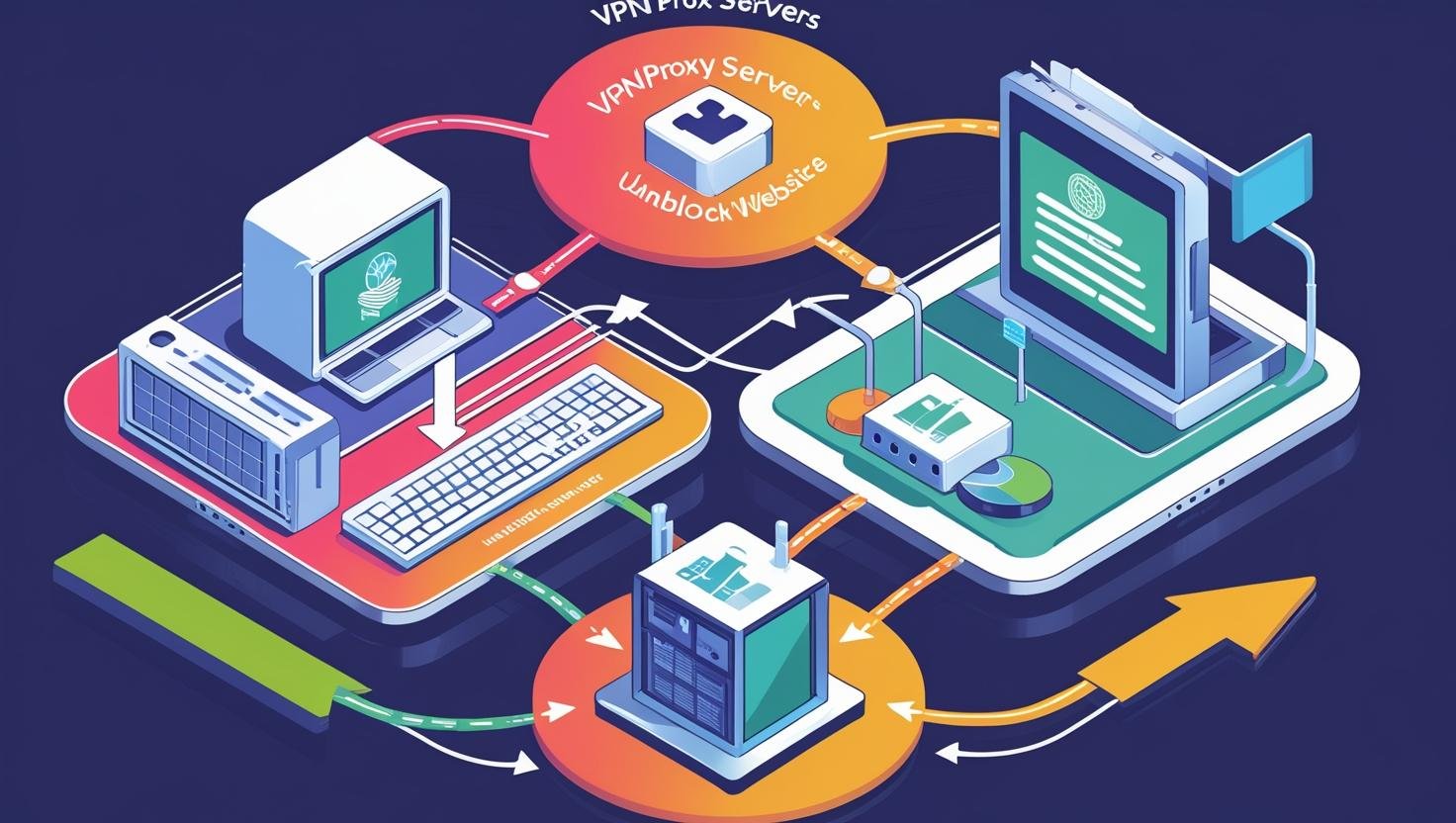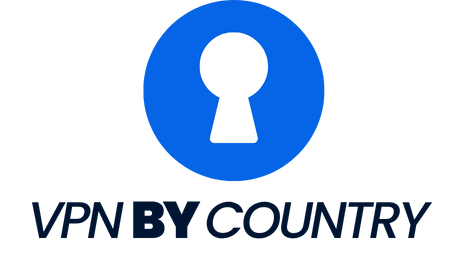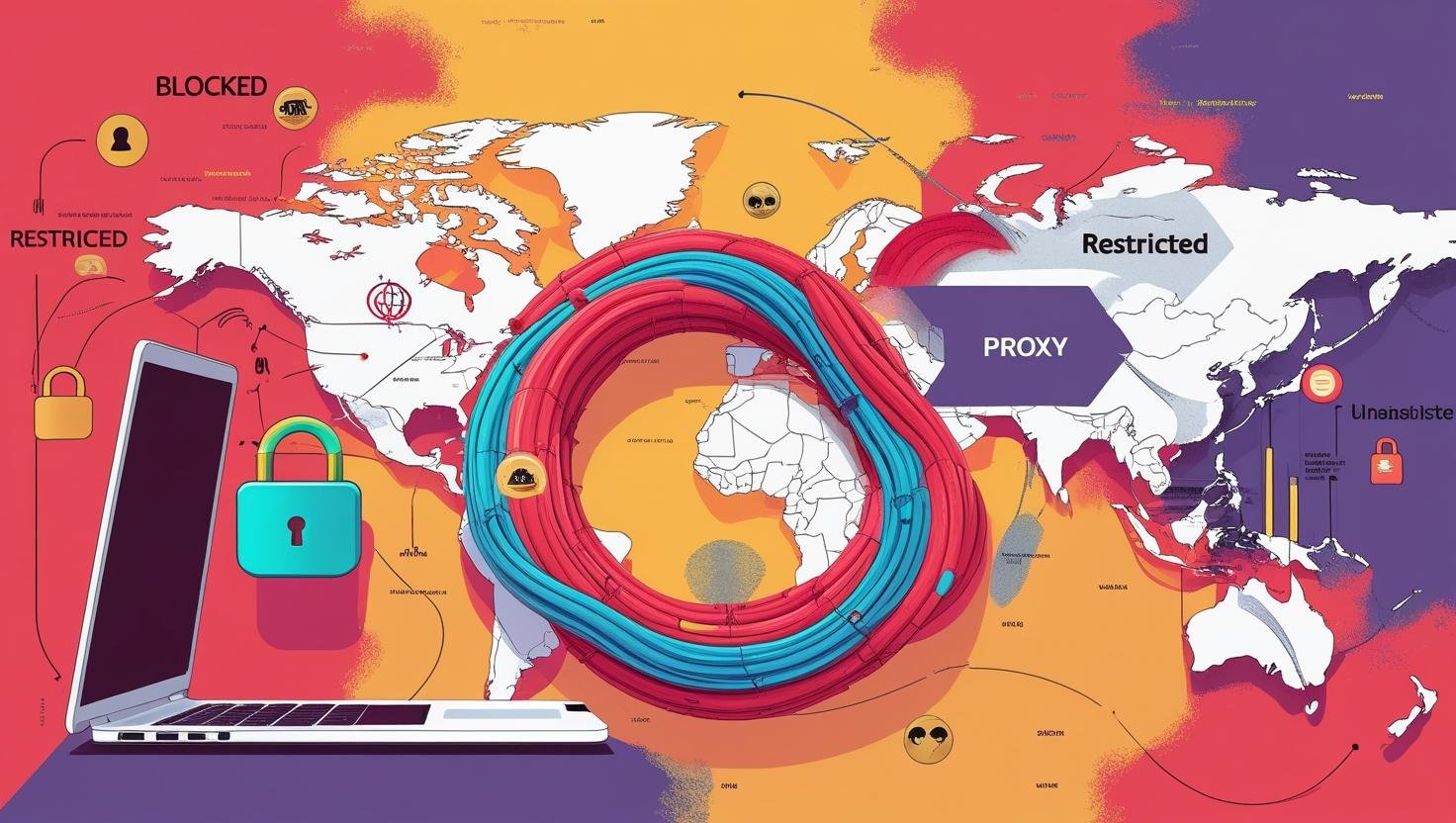Have you ever tried to access a website, only to be met with a frustrating “Access Denied” message? Learning **how to unblock websites** is becoming increasingly essential in today’s digital landscape. Whether it’s a social media platform, a news site, a streaming service, or just a specific piece of content, encountering blocked websites is a common experience for internet users worldwide. These restrictions can stem from various sources, including government censorship, geographical limitations imposed by content providers, or even network firewalls in workplaces and schools. This digital blockade not only limits your online freedom but can also prevent you from accessing vital information or entertainment.
Fortunately, there are powerful tools designed to help you bypass these digital barriers: Virtual Private Networks (VPNs) and Proxies. These technologies act as intermediaries, allowing you to route your internet traffic through a different server, effectively masking your real location and identity. In this comprehensive guide, we’ll dive deep into how VPNs and proxies work, explore their differences, and provide you with clear, actionable steps to **unblock any website** safely and securely, giving you back control over your online experience.
The Difference Between VPN and Proxy: Understanding How to Unblock Websites Securely
While both VPNs and proxies serve to route your internet traffic through a remote server, making it appear as if you’re Browse from a different location, their functionality, security levels, and intended uses vary significantly. Understanding these differences is crucial for choosing the right tool for your **unblock websites** needs.
What is a VPN?
A Virtual Private Network (VPN) creates a secure, encrypted “tunnel” between your device and a VPN server. All your internet traffic passes through this tunnel, making it unreadable to anyone trying to intercept it, including your Internet Service Provider (ISP) or government surveillance. Your original IP address is masked by the VPN server’s IP address, making it appear as though you are Browse from the server’s location.
- Key Benefits: Strong encryption (e.g., AES-256), robust security protocols, hides your IP address, protects your privacy, prevents tracking, and can bypass most geo-restrictions and censorship.
- Use Cases: Ensuring online privacy and anonymity, secure Browse on public Wi-Fi, accessing geo-restricted streaming content, bypassing strict internet censorship, secure torrenting.
What is a Proxy?
A proxy server acts as an intermediary between your device and the internet. When you use a proxy, your requests go to the proxy server first, which then forwards them to the website you want to visit. The website sees the proxy’s IP address instead of yours. However, unlike a VPN, most proxies typically do not encrypt your internet traffic.
- Types of Proxies:
- HTTP Proxy: Used for web Browse, often integrated into browsers or specific apps. Less secure.
- SOCKS Proxy: More versatile than HTTP, can handle any type of traffic (web, email, torrenting). Still lacks encryption.
- Web Proxy: A website you visit to route your traffic, often simpler for quick unblocking but generally less secure and slower.
- Key Features: Hides your IP address, can bypass basic geo-restrictions, generally faster than VPNs for simple tasks (due to lack of encryption overhead).
- Limitations: Lack of encryption means your data can still be intercepted. May not bypass advanced firewalls. Not suitable for sensitive activities.
Comparison Table: VPN vs. Proxy
| Feature | VPN (Virtual Private Network) | Proxy Server |
|---|---|---|
| Encryption | Strong (AES-256) | None or very weak |
| Security | High (Protects all traffic) | Low (Often limited to specific apps/browsers) |
| Privacy | High (Hides IP, no-logs policy common) | Low (Can log your activity, no privacy guarantee) |
| Speed Impact | Moderate slowdown (due to encryption) | Minimal slowdown (can be faster for unencrypted traffic) |
| Bypass Capability | High (Bypasses strong censorship, geo-blocks) | Moderate (Bypasses basic geo-blocks, simpler firewalls) |
| Cost | Usually paid (reliable services) | Often free (with significant risks) |
As you can see, for comprehensive online security, privacy, and robust unblocking, a VPN is almost always the superior choice. Proxies offer a quick fix for simple unblocking but come with significant risks, especially if they are free.
How to Unblock Websites Using a VPN: Step-by-Step Guide
Using a VPN is the most reliable and secure method for accessing blocked websites. Follow these simple steps to regain your online freedom:
1. Choose a Reputable VPN Service for Unblocking
This is the most critical step. Avoid free VPNs if you value your privacy and security. Reliable paid VPNs offer robust encryption, strict no-logs policies, and a wide network of servers. Some top recommendations include:
- ExpressVPN (Excellent for speed and unblocking, including in restricted countries like Pakistan)
- NordVPN (Massive server network, strong security features)
- Surfshark (Unlimited devices, great for streaming)
- Proton VPN (Strong focus on privacy, good free tier for basic use)
For a detailed analysis of these providers and more, especially their performance in specific regions, check our article on Best VPN for Pakistan in 2025: Reclaim Your Digital Freedom.
2. Download and Install the VPN App to Unblock
Once you’ve chosen a VPN, visit their official website and download the appropriate app for your device (Windows, macOS, Android, iOS, Linux, router, etc.). Follow the installation instructions, which are usually straightforward.
3. Log In and Connect to a Server
Open the VPN application and log in with your credentials. You’ll typically see a list of server locations. To unblock a website, choose a server in a country where the website is not blocked. For example, if Netflix content is blocked in your country but available in the US, connect to a US server.
- Tip for Censorship: In highly censored countries, look for VPNs with obfuscated (stealth) servers. These are designed to hide the fact that you’re using a VPN, making your encrypted traffic look like regular internet traffic.
4. Access the Blocked Website Easily
Once connected to the VPN server, open your web browser or application and try accessing the previously blocked website. It should now be accessible, as your internet traffic appears to originate from the VPN server’s location.
How to Unblock Websites Using a Proxy: Quick Methods & Risks
While less secure, proxies can be used for quick, basic unblocking of websites, especially if you’re not dealing with highly sensitive information or advanced censorship. However, it’s crucial to understand their limitations and risks.
1. Using a Web Proxy
Web proxies are websites that allow you to browse other websites through them. They are the simplest to use:
- Go to a reputable web proxy site (e.g., CroxyProxy, ProxySite). **Note:** Be cautious, as many free web proxies are riddled with ads or can compromise your privacy.
- Enter the URL of the website you want to **unblock** into the proxy site’s address bar.
- Click “Go” or “Browse” to access the website.
While convenient, web proxies offer minimal to no encryption, making your activity potentially visible to your ISP or network administrator. They are not recommended for logging into accounts or handling personal data.
2. Configuring Proxy Settings in Your Browser
Some browsers or operating systems allow you to manually configure proxy settings. This typically involves getting a proxy IP address and port from a proxy list (often found on specialized websites). This method is more involved and still lacks the comprehensive security of a VPN.
For example, in Chrome, you can go to Settings > System > Open your computer’s proxy settings and enter the details. This will route all browser traffic through the proxy.
The Risks of Free Proxies for Unblocking Websites
The allure of “free” comes with a cost, especially with proxy services. Many free proxies:
- Log Your Data: They might monitor and store your Browse history, personal information, and even login credentials, which can then be sold to third parties.
- Inject Ads & Malware: Free proxy sites often insert their own ads into the websites you visit, or even embed malicious code that can compromise your device.
- Are Unreliable: They are frequently slow, overloaded, and prone to sudden disconnections, leading to a frustrating user experience.
- Offer No Encryption: Without encryption, your internet traffic remains vulnerable to eavesdropping, making them unsuitable for any sensitive online activities.
Given these risks, free proxies should only be used for the most basic, non-sensitive unblocking tasks, if at all. For true security and privacy, a VPN is indispensable when you aim to **unblock websites**.
Other Powerful Solutions for How to Unblock Websites
Beyond VPNs and proxies, other tools can help you access blocked content, each with its own advantages and disadvantages.
1. Smart DNS for Unblocking Streaming
Smart DNS services work by re-routing your DNS queries through servers in a different country, making websites believe you are located elsewhere. They are generally faster than VPNs because they don’t encrypt your traffic, which also means they don’t offer the same level of security or privacy.
- Pros: High speed, good for streaming geo-restricted content.
- Cons: No encryption, no privacy protection, limited for bypassing strict censorship.
2. Tor Browser for Anonymous Unblocking
The Tor (The Onion Router) browser is a free, open-source software that enables anonymous communication. It routes your internet traffic through a vast network of volunteer-operated relays worldwide, encrypting it multiple times. This makes it extremely difficult to trace your online activity back to you.
- Pros: High anonymity, very effective at bypassing censorship.
- Cons: Very slow due to multi-layer encryption and routing, not suitable for streaming or torrenting, can attract unwanted attention from authorities in highly censored regions. For a general understanding of Tor and internet censorship, you can refer to Wikipedia’s page on Internet censorship.

Essential Security Tips for Unblocking Websites Safely
While unblocking websites can grant you digital freedom, it’s vital to prioritize your security and privacy. Here are some crucial tips:
- Always Choose Reputable Services: For VPNs, stick to well-known, audited, and paid providers. Avoid free services that might compromise your data.
- Verify No-Logs Policies: Ensure your chosen VPN has a strict, independently verified no-logs policy. This guarantees your online activities are not recorded. Find out more about this in our guide on the Best VPN for Privacy in 2025: Protecting Your Digital Footprint.
- Keep Software Updated: Regularly update your VPN app, browser, and operating system to protect against vulnerabilities.
- Be Wary of Phishing: Phishing attempts are common. Always double-check URLs before entering credentials, especially when using proxies.
- Use Strong Passwords: Even with a VPN, strong, unique passwords are your first line of defense against account breaches.
- Understand Local Laws: While VPN usage is generally legal in many places, some countries have specific regulations or outright bans. Always be aware of your local legal landscape regarding **how to unblock websites**.
Frequently Asked Questions About How to Unblock Websites (FAQs)
1. Is it legal to unblock websites?
The legality depends heavily on your location and the reason for the blocking. In many countries, using a VPN or proxy to access content is perfectly legal, especially if you’re bypassing geo-restrictions for streaming. However, some countries have strict internet censorship laws where using such tools might be restricted or require registration (like in Pakistan). Always consult local laws, and ensure your activities are legal.
2. Will using a VPN slow down my internet?
A slight slowdown is normal due to encryption and server routing. However, with a premium VPN service, this impact is often negligible for daily Browse and streaming. In some cases, a VPN can even improve speed by bypassing ISP throttling.
3. Can I unblock websites for free?
Yes, you can use free VPNs or free web proxies, but they come with significant risks to your privacy, security, and performance. Many free services log your data, inject ads, or are unreliable. Investing in a reputable paid VPN is highly recommended for a safe and consistent experience.
4. Which is better for unblocking: VPN or proxy?
For comprehensive security, privacy, and reliable unblocking, a VPN is superior. Proxies are only suitable for very basic, non-sensitive unblocking where security isn’t a concern.
5. Can I use a VPN to access Netflix libraries in other countries?
Yes, VPNs are widely used to access different Netflix libraries by connecting to a server in the desired country. However, Netflix is actively blocking VPNs, so choosing a VPN known for its strong streaming unblocking capabilities is important. For more on this, see our article: VPN for Netflix in 2025 – How to Unblock Global Libraries.
Conclusion and Recommendations for Unblocking Websites
The internet, while a global platform for information and connection, is increasingly fragmented by various forms of blocking and censorship. Understanding **how to unblock websites** is essential for maintaining your online freedom and privacy. As this guide has shown, Virtual Private Networks (VPNs) stand out as the most robust and secure solution for unblocking websites and bypassing internet censorship.
VPNs offer comprehensive encryption, mask your true IP address, and protect your online activities from surveillance, making them invaluable tools in restrictive environments. While proxies can offer quick, basic unblocking, their lack of encryption and potential privacy risks make them unsuitable for sensitive Browse or sustained online freedom.
When choosing a VPN, prioritize services known for strong security features, audited no-logs policies, high speeds, and proven unblocking capabilities. Remember that free VPNs often come with hidden costs related to your data privacy and security, making them a less advisable choice for serious users.
By implementing the strategies outlined in this guide, you can confidently access the content you desire, protect your digital footprint, and enjoy a truly open and secure internet experience. Reclaim your right to information and unrestricted Browse with the right tools at your disposal.

